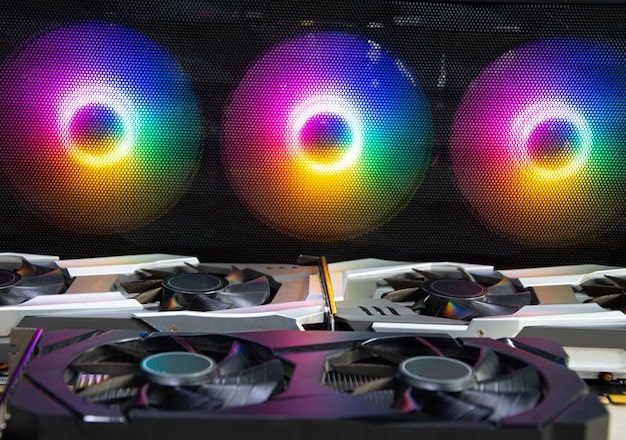Ultrawide monitors for gaming: are they truly worth the investment?

Ultrawide monitors offer an unparalleled immersive gaming experience due to their expanded field of view and cinematic aspect ratios, but their perceived value as an investment hinges on understanding their specific advantages against traditional setups for different gaming genres and hardware requirements.
For gamers seeking to elevate their setup, the question often arises: are ultrawide monitors truly worth the investment for immersive gaming? These displays promise a wider field of view, pulling players deeper into virtual worlds. Yet, their cost and specific requirements warrant a closer look.
The Evolution of Gaming Displays: From Standard to Ultrawide
The journey of gaming displays has seen significant transformations, moving from bulky CRTs to sleek, high-definition flatscreens. Each iteration brought improvements in resolution, refresh rates, and color fidelity, aiming to enhance the player’s visual experience. The advent of ultrawide monitors marks another pivotal chapter in this evolution, fundamentally altering how games are perceived and interacted with.
Traditional monitors, typically with a 16:9 aspect ratio, have been the longstanding norm. While perfectly adequate for most applications, they offer a somewhat confined view, especially in games designed for expansive exploration or fast-paced action. Ultrawide monitors, typically adopting a 21:9 or even 32:9 aspect ratio, break these conventional boundaries, presenting a wider panoramic view that can drastically change the sense of immersion.
Understanding Aspect Ratios and Field of View
The aspect ratio of a monitor defines the proportional relationship between its width and its height. A 16:9 monitor means for every 16 units of width, there are 9 units of height. Ultrawide monitors extend this width, offering ratios like 21:9 (similar to cinematic movie screens) or the super ultrawide 32:9, which effectively provides the screen space of two 16:9 monitors side-by-side without a bezel in the middle.
- 16:9: Standard, widely supported, versatile for most media and gaming.
- 21:9: Offers a significant horizontal expansion, ideal for cinematic experiences and increasing peripheral vision in games.
- 32:9: The broadest consumer option, providing an extreme field of view, almost like having two monitors merged.
This increased horizontal real estate, known as the Field of View (FOV), is where ultrawide monitors shine in gaming. In first-person shooters, racing games, or open-world adventures, a wider FOV can mean seeing more of your surroundings without panning the camera, offering both a strategic advantage and a heightened sense of presence. The transition from a standard 16:9 to an ultrawide display often feels like a veil being lifted, revealing details on the periphery that were previously unseen.
The initial appeal of an ultrawide monitor lies in its visual impact. The sheer breadth of the display wraps around the user’s peripheral vision, drawing them more deeply into the game world. This enhanced peripheral awareness can be particularly advantageous in genres where situational awareness is key, such as racing simulators or flight sims where seeing more of the cockpit or track ahead can make a tangible difference. Beyond the immediate sensory impact, the wider aspect ratio can also provide a practical edge, allowing for more information to be displayed simultaneously, whether it’s more of the battlefield or additional interface elements without cluttering the central view.
The Immersion Factor: How Ultrawide Enhances Gaming Experience
The primary allure of ultrawide monitors for gamers is the promise of unparalleled immersion. This goes beyond mere visual appeal; it’s about altering the fundamental way a player experiences a game. The expanded field of view (FOV) is central to this, offering a distinct advantage and a more engaging sensory experience.
Expanded Field of View and Peripheral Vision
One of the most noticeable benefits of an ultrawide monitor is the significant expansion of the horizontal field of view. This means that in compatible games, you see more of the environment on either side of your central vision. This isn’t just about aesthetics; it has practical implications. In competitive games, it can provide a tactical edge by allowing players to spot enemies or objectives in their peripheral vision without having to physically pan the camera as much. In open-world games, it deepens the sense of scale and exploration.
The human eye naturally has a wider horizontal field of vision than vertical. Ultrawide monitors align more closely with this natural perception, making the on-screen action feel more natural and less like looking through a window. The additional visual information available at the edges of the screen actively pulls the player’s brain into the simulated environment, making the experience more engrossing.
The Cinematic Advantage in Gaming
Many ultrawide monitors feature a 21:9 aspect ratio, which is the same as the cinematic widescreen format used in many films. This aspect ratio eliminates the black bars often found at the top and bottom of the screen when viewing movies on a 16:9 monitor, providing a true cinematic experience. In gaming, this translates into a broader, more epic perspective. Games that support ultrawide resolutions seamlessly can feel more like interactive movies, especially those with strong narratives and expansive landscapes.
- Reduced screen tearing: Many ultrawide monitors come with high refresh rates and adaptive sync technologies.
- Enhanced story engagement: The wider frame often complements in-game cinematography and cutscenes, making them more impactful.
- Deeper environmental detail: More of the game world is visible, allowing for greater appreciation of artistic design and intricate details that might be missed on a narrower screen.
The sheer physical presence of a large ultrawide display, especially curved models, contributes significantly to immersion. A curved panel gently wraps the edges of the screen around the viewer, creating a more uniform viewing distance and further drawing the player into the center of the action. This subtle curvature can reduce eye strain and enhance the feeling of being “inside” the game, as the pixels extend further into the user’s peripheral vision. This combination of visual breadth and ergonomic design works in tandem to create a truly captivating gaming experience that standard monitors struggle to replicate.
Performance and Compatibility Considerations
While the allure of an ultrawide monitor for immersive gaming is strong, it’s crucial to address the practical implications on system performance and game compatibility. Driving these expansive displays requires more computational power, and not all games are designed to fully leverage their unique aspect ratios.
Graphics Card Demands and System Requirements
The most significant performance consideration when stepping up to an ultrawide monitor is the increased demand on your graphics card (GPU). Ultrawide resolutions, such as 3440×1440 or 5120×1440, contain significantly more pixels than a standard 1920×1080 (1080p) or even 2560×1440 (1440p) display.
- A 3440×1440 ultrawide monitor has approximately 4.95 million pixels, compared to 2.07 million for 1080p and 3.68 million for 1440p.
- A super ultrawide 5120×1440 monitor boasts over 7.37 million pixels.
Rendering more pixels means your GPU has to work harder to maintain high frame rates. This translates to the need for a more powerful graphics card, especially if you aim to play modern AAA titles at high settings with smooth frame rates. Upgrading to an ultrawide without a capable GPU can lead to disappointing performance, frame drops, and a less enjoyable experience than anticipated.
Furthermore, the CPU and RAM can also play a role, as complex game logic and asset loading can be more taxing when paired with higher resolutions. It’s not uncommon for gamers to find themselves needing to upgrade multiple components of their system to fully realize the benefits of an ultrawide setup.

Game Support and Potential Issues
While ultrawide support has improved dramatically over the years, it’s still not universal. Most modern AAA games tend to support ultrawide resolutions natively or through minor in-game settings adjustments. However, older titles, indie games, or those primarily developed for consoles might struggle. Issues can range from:
- Black bars: Many games, especially older ones, will simply display black bars on the sides of the screen to maintain a 16:9 aspect ratio, negating the ultrawide advantage.
- Stretched HUD/UI: The user interface (HUD) or on-screen elements might appear stretched or misplaced, which can be visually jarring and even impact gameplay.
- Field of View (FOV) issues: In some cases, the FOV might be vertically cropped to fit the horizontal expansion, resulting in a “zoomed-in” feeling that reduces immersion rather than enhancing it.
- Cutscenes: Cinematic cutscenes are often pre-rendered at 16:9, leading to black bars even if the gameplay supports ultrawide.
The gaming community has developed various third-party tools and mods to address these compatibility issues for unsupported games. Websites and forums dedicated to ultrawide gaming often provide workarounds and compatibility lists. However, relying on community fixes can sometimes be a cumbersome process, requiring manual adjustments and potentially introducing instability to games. Therefore, researching game compatibility for your preferred titles before investing in an ultrawide monitor is advisable. The landscape is continually improving, but a degree of vigilance is still warranted to ensure a seamless experience across your game library.
Types of Ultrawide Monitors: Flat vs. Curved
When considering an ultrawide monitor, one of the most prominent design choices you’ll encounter is between a flat panel and a curved one. Both have their merits and drawbacks, particularly concerning gaming immersion and overall user experience. The decision often boils down to personal preference, specific use cases, and budget.
The Case for Curved Ultrawides
Curved ultrawide monitors are often touted as the pinnacle of immersive gaming displays. The curvature is designed to follow the natural field of vision of the human eye, attempting to keep all points of the screen equidistant from the viewer’s eyes. This design aims to create a more natural and comfortable viewing experience, especially on larger displays where the edges of a flat screen might feel too far away or introduce distorted perspectives.
For gaming, the benefits of a curved display are numerous:
- Enhanced Immersion: The most significant advantage is the feeling of being “wrapped” by the image. This can pull you deeper into the game world, making action feel more immediate and encompassing.
- Reduced Eye Strain: By maintaining a more consistent focal distance across the entire screen, a curved monitor can potentially reduce eye fatigue during long gaming sessions.
- Improved Peripheral Awareness: The gentle curve brings the edges of the display slightly closer, allowing for better peripheral vision in games where seeing on-screen elements at the corners is crucial.
- Consistent Visual Quality: On a very wide flat screen, colors and contrast might appear slightly different at the extreme edges when viewed from a central position due to off-axis viewing. Curvature mitigates this.
Curved monitors typically come in various radii, such as 1800R or 1000R, with smaller numbers indicating a more aggressive curve. A tighter curve can further enhance the feeling of immersion, but it’s important to consider seating distance and desk space when choosing the right curvature.
Flat Ultrawides: Practicality and Versatility
While curved ultrawides are often the go-to for gamers, flat ultrawide monitors still hold a significant place in the market. They tend to be more affordable, and for certain use cases, they might even be preferable. The absence of curvature can be an advantage in scenarios beyond pure gaming.
Here are some reasons why a flat ultrawide might be a suitable choice:
- Multi-purpose Use: For users who frequently switch between gaming, detailed graphic design, video editing, or productivity tasks that require precise straight lines and geometry, a flat screen can be more accurate and less prone to perceived distortion.
- Cost-effectiveness: Generally, flat ultrawides are less expensive to manufacture than their curved counterparts, translating to lower retail prices for consumers.
- Reduced Glare Perception: In some environments, reflection patterns on a curved screen can be more distracting than on a flat one, depending on light source position.
- Desk Space and Aesthetics: Some users simply prefer the aesthetic of a flat monitor or find it fits better into their existing desk setup without feeling overwhelming.
The choice between flat and curved largely comes down to what you prioritize. For a purely immersive gaming experience, especially with larger displays, a curved ultrawide is often recommended. However, for those who value versatility across various applications, a more budget-friendly option, or simply prefer a traditional flat viewing experience, a flat ultrawide remains a strong contender. Both offer the core benefit of expanded screen real estate, and the “best” choice is ultimately subjective.
Beyond Gaming: Productivity and Entertainment Benefits
While gaming immersion is a primary driver for many considering ultrawide monitors, their benefits extend far beyond the virtual battlegrounds. These displays offer significant advantages in productivity and general entertainment, making them a compelling investment for a diverse range of users.
Revolutionizing Workflows with Expanded Desktop Space
For professionals and students, an ultrawide monitor can dramatically enhance multitasking capabilities and workflow efficiency. The generous horizontal screen real estate effectively replaces a multi-monitor setup without the distraction of bezels. This single, expansive canvas allows users to arrange multiple windows side-by-side with ease, streamlining various tasks.
- Content Creation: Video editors can have their timeline stretched across the entire screen, while graphic designers can view large canvases alongside their toolbars and reference images without constant alt-tabbing.
- Data Analysis: Spreadsheets with numerous columns become more manageable, and financial traders can monitor multiple live data feeds simultaneously.
- Coding and Writing: Developers can display their code editor next to a browser for documentation or a real-time preview of their work. Writers can have their word processor open alongside research materials.
- Virtual Meetings: Participants in video conferences can keep meeting software open while simultaneously referencing documents or taking notes, all on one screen.
Many ultrawide monitors come with built-in software features that allow for easy screen splitting and window arrangement, further optimizing the desktop for productivity. This seamless integration of multiple applications on a single display significantly reduces the time spent switching between windows and improves overall focus, leading to a more efficient and less cluttered digital workspace.

An Immersive Experience for Movies and Media
Beyond gaming, ultrawide monitors provide a truly cinematic viewing experience for movies and TV shows, particularly those filmed in a 21:9 aspect ratio. Unlike 16:9 monitors where content with a wider aspect ratio (e.g., films) results in black bars at the top and bottom, ultrawide screens eliminate these, filling the entire display with content. This truly edge-to-edge viewing dramatically enhances immersion, making viewers feel more engrossed in the visual narrative.
For general web browsing and media consumption, the extra width offers more space for content without excessive scrolling. While not all YouTube videos or streaming content might natively support ultrawide, many platforms are adapting, and the benefits for cinematic content are undeniable. Whether it’s watching the latest blockbuster or diving into a documentary, an ultrawide monitor transforms the viewing experience, making it more akin to a personal theater. The crisp visuals and expansive display contribute to a premium media consumption environment that standard displays simply cannot match, further cementing the ultrawide as a versatile investment.
Cost-Benefit Analysis: Is the Investment Justified?
Deciding if an ultrawide monitor is a worthwhile investment involves weighing the unique advantages against the additional cost and potential drawbacks. It’s not a simple yes or no answer, as the value proposition varies significantly depending on individual needs, budget, and gaming preferences.
Weighing the Price Against Performance Gains
Ultrawide monitors typically command a higher price tag than their 16:9 counterparts, especially those with high refresh rates, adaptive sync technologies (G-Sync or FreeSync), and premium panel types (e.g., OLED). This initial investment is a significant hurdle for many. However, the cost should be considered in relation to the tangible benefits provided, particularly in gaming immersion:
- Enhanced immersion: For gamers who value being deeply pulled into their virtual worlds, the panoramic view and reduced distraction of bezels can be priceless. This is where ultrawides truly differentiate themselves.
- Competitive edge: In certain genres like racing sims or open-world exploration, the expanded FOV can offer a subtle but meaningful advantage by providing more visual information.
- “Future-proofing”: As game development increasingly embraces wider aspect ratios, an ultrawide purchase can be seen as an investment in a more future-ready setup.
However, the performance cost must also be factored in. Forcing a powerful graphics card to render more pixels ultimately means lower frame rates compared to a 16:9 monitor with the same hardware. This could necessitate an upgrade to a more powerful GPU, further increasing the overall investment. For casual gamers or those on a strict budget, these additional costs coupled with potential game compatibility issues might outweigh the benefits.
Who Benefits Most from an Ultrawide Monitor?
The “worth” of an ultrawide monitor is highly subjective and depends on the user’s profile:
Gamers Who Will Find Value:
- Immersion Seekers: Players who prioritize complete immersion in single-player, story-driven games, RPGs, or open-world titles will find the cinematic experience profoundly rewarding.
- Simulation Enthusiasts: Racing, flight, and space simulation fans benefit immensely from the increased peripheral vision, making the experience more realistic and controllable.
- Competitive Edge Seekers (Specific Games): While not universal, some competitive gamers in titles that support ultrawide FOV natively might appreciate the wider view.
- Content Creators/Producers: Those who game and also engage in video editing, graphic design, or music production will appreciate the productivity gains alongside gaming benefits.
Gamers Who Might Not Find It Worthwhile:
- Budget-Conscious Gamers: If upgrading your GPU is not an option, an ultrawide might lead to a suboptimal gaming experience due to lower frame rates.
- High FPS Competitive Gamers (Esports): For esports titles where every frame matters and the focus is on raw performance and quick reflexes, a very high refresh rate 16:9 monitor might be preferred due to optimized game scaling and lower hardware demands.
- Exclusive Console Gamers: Console games are almost exclusively designed for 16:9 displays, meaning an ultrawide will likely display black bars.
- Casual Gamers: For those who only game occasionally and don’t seek cutting-edge immersion, a standard high-refresh-rate 16:9 display offers excellent value.
Ultimately, the investment is justified for those who will genuinely utilize and appreciate the enhanced immersion and productivity benefits. For these users, an ultrawide monitor can transform their digital experience, making the higher price tag a worthwhile trade-off for the enriched visual landscape it provides.
Tips for Choosing the Right Ultrawide Gaming Monitor
Selecting the ideal ultrawide gaming monitor requires careful consideration of several technical specifications to match your specific needs, budget, and existing hardware. Making an informed decision ensures you get the most out of your investment and enjoy the truly immersive experience these monitors can offer.
Key Specifications to Look For
Beyond screen size and curvature (which we’ve already covered), several other technical aspects play a critical role in monitor performance and your overall gaming satisfaction:
- Resolution: The most common ultrawide resolutions are 3440×1440 and 2560×1080. While 2560×1080 is less demanding on your GPU, 3440×1440 offers significantly more screen real estate and sharper visuals, making it generally preferred for a premium experience. Super ultrawide monitors might offer 5120×1440, demanding even more from your system.
- Refresh Rate (Hz): This indicates how many times the screen refreshes per second. Higher refresh rates (e.g., 120Hz, 144Hz, 240Hz) result in smoother motion, which is crucial for fast-paced games. Aim for at least 120Hz for a noticeable improvement over standard 60Hz displays.
- Response Time (ms): This measures how quickly pixels can change color. Lower response times (1ms to 5ms GTG are common for gaming monitors) reduce motion blur and ghosting, leading to crisper visuals, especially during rapid movement.
- Panel Type:
- IPS (In-Plane Switching): Offers excellent color accuracy and wide viewing angles, making them great for both gaming and content creation. Response times have improved significantly.
- VA (Vertical Alignment): Known for superior contrast ratios and deep blacks, providing a more immersive visual experience, especially in darker games. Response times can sometimes be slower than IPS or TN.
- TN (Twisted Nematic): Traditionally offered the fastest response times and highest refresh rates, but at the cost of narrower viewing angles and less accurate color reproduction. Less common in ultrawide gaming monitors now.
- OLED (Organic Light-Emitting Diode): The pinnacle for image quality with perfect blacks, infinite contrast, and extremely fast response times. They are typically the most expensive and can carry a risk of burn-in over time, though modern panels are highly resistant.
- Adaptive Sync Technology (NVIDIA G-Sync/AMD FreeSync): These technologies synchronize the monitor’s refresh rate with your GPU’s frame rate, eliminating screen tearing and stuttering. Ensure the monitor supports the sync technology compatible with your graphics card (G-Sync for NVIDIA, FreeSync for AMD, though many FreeSync monitors are now G-Sync Compatible).
Matching Monitor to Hardware and Budget
Your existing PC hardware, particularly your graphics card, is a principal factor in your monitor choice. A top-tier ultrawide monitor paired with a mid-range GPU will not deliver optimal performance. Conversely, a powerful GPU will be bottlenecked by a low-refresh-rate monitor. Aim for a balanced setup where your GPU can consistently push high frame rates at your chosen ultrawide resolution.
Budget is another practical constraint. High-end ultrawides with all the bells and whistles (high resolution, high refresh rate, curved, OLED) can be quite expensive. It’s often necessary to make trade-offs. Prioritize the features most important to your gaming experience:
- If competitive gaming is key, prioritize refresh rate and response time.
- If visual fidelity and immersion in single-player games are paramount, prioritize resolution, panel type (e.g., VA or OLED), and maybe curvature.
Research specific models, read reviews from reputable sources, and compare prices across different retailers. Consider warranties and return policies. Ultimately, the best ultrawide monitor is one that fits your budget, complements your gaming habits, and extracts the maximum potential from your PC setup. This thoughtful approach will ensure your investment genuinely enhances your gaming immersion for years to come.
Conclusion: The Ultrawide Verdict
After a thorough examination of ultrawide monitors, their unique capabilities, and practical considerations, the verdict on their worth for immersive gaming becomes clear: they are indeed a significant upgrade for the right user, offering an unparalleled level of immersion unmatched by traditional displays. The expanded field of view, cinematic aspect ratios, and the potential for a wrapped, consistent viewing experience via curved panels undeniably elevate the gaming experience, pulling players deeper into virtual worlds and often enhancing situational awareness.
However, this enhanced immersion comes with notable prerequisites and investments. The demand on your graphics card is considerably higher, often necessitating an upgrade to a more powerful GPU to maintain smooth frame rates at ultrawide resolutions. Game compatibility, while vastly improved, is still not universal, and some titles may require adjustments or exhibit black bars during cutscenes. The initial cost of a high-quality ultrawide monitor is also a factor, positioning it as a premium investment.
For the dedicated gamer who prioritizes deep immersion, particularly in genres like open-world adventures, racing simulators, or flight sims, and who possesses (or plans to acquire) the necessary hardware to drive these displays, an ultrawide monitor is unequivocally worth the investment. Beyond gaming, their productivity benefits, by providing expansive desktop space for multitasking, further sweeten the deal for many users. Conversely, for budget-conscious gamers, those primarily playing competitive esports titles focused on raw frame rates, or console-exclusive players, the investment might not yield sufficient returns.
In essence, ultrawide monitors are not just a trend; they represent a tangible evolution in display technology that fundamentally enhances how we interact with digital content. For those who can meet their demands, they offer a captivating and truly immersive gaming and computing experience that standard monitors simply cannot replicate, making them a valuable, long-term addition to a high-performance setup.
| Key Point | Brief Description |
|---|---|
| 🎮 Immersion Factor | Ultrawide monitors offer an expanded field of view, pulling gamers deeper into virtual worlds. |
| 💪 Performance Demands | Requires a powerful GPU to maintain high frame rates due to increased pixel count. |
| 📊 Productivity Boost | Offers significant multitasking benefits, effectively replacing multi-monitor setups. |
| 💰 Cost vs. Value | A premium investment justified for those prioritizing immersion and extensive screen real estate. |
Frequently Asked Questions about Ultrawide Monitors for Gaming
For most immersive gaming, a 21:9 aspect ratio is considered optimal. It provides a cinematic feel and significant horizontal expansion without being overly demanding on hardware like super ultrawide 32:9. Many games are best optimized for 21:9, offering a balance between immersion and compatibility.
Yes, running games at ultrawide resolutions (e.g., 3440×1440) demands significantly more processing power from your graphics card than standard 1080p or 1440p resolutions. Your frame rates will likely be lower, potentially requiring a GPU upgrade to maintain smooth performance for modern AAA titles at high settings.
For gaming immersion, curved ultrawide monitors are generally preferred. The curvature helps wrap the image around your field of view, creating a more enveloping experience and maintaining a consistent viewing distance across the screen. For productivity or graphic design with straight lines, a flat screen might be more suitable.
While ultrawide support has improved, not all games natively support these resolutions. Modern AAA titles generally do, but older games, indie titles, or console ports might display black bars on the sides, stretch the UI, or have FOV issues. Community patches or mods often exist as workarounds for unsupported titles.
For a 3440×1440 ultrawide, a powerful mid-to-high-end GPU like an NVIDIA RTX 3070/4070 or AMD RX 6700XT/7700XT is a reasonable starting point for decent frame rates in many games. For maxed-out settings or higher refresh rates, you’d want an RTX 3080/4080 or RX 6800XT/7800XT and above.
Conclusion
After a thorough examination of ultrawide monitors, their unique capabilities, and practical considerations, the verdict on their worth for immersive gaming becomes clear: they are indeed a significant upgrade for the right user, offering an unparalleled level of immersion unmatched by traditional displays. The expanded field of view, cinematic aspect ratios, and the potential for a wrapped, consistent viewing experience via curved panels undeniably elevate the gaming experience, pulling players deeper into virtual worlds and often enhancing situational awareness.
However, this enhanced immersion comes with notable prerequisites and investments. The demand on your graphics card is considerably higher, often necessitating an upgrade to a more powerful GPU to maintain smooth frame rates at ultrawide resolutions. Game compatibility, while vastly improved, is still not universal, and some titles may require adjustments or exhibit black bars during cutscenes. The initial cost of a high-quality ultrawide monitor is also a factor, positioning it as a premium investment.
For the dedicated gamer who prioritizes deep immersion, particularly in genres like open-world adventures, racing simulators, or flight sims, and who possesses (or plans to acquire) the necessary hardware to drive these displays, an ultrawide monitor is unequivocally worth the investment. Beyond gaming, their productivity benefits, by providing expansive desktop space for multitasking, further sweeten the deal for many users. Conversely, for budget-conscious gamers, those primarily playing competitive esports titles focused on raw frame rates, or console-exclusive players, the investment might not yield sufficient returns.
In essence, ultrawide monitors are not just a trend; they represent a tangible evolution in display technology that fundamentally enhances how we interact with digital content. For those who can meet their demands, they offer a captivating and truly immersive gaming and computing experience that standard monitors simply cannot replicate, making them a valuable, long-term addition to a high-performance setup.





